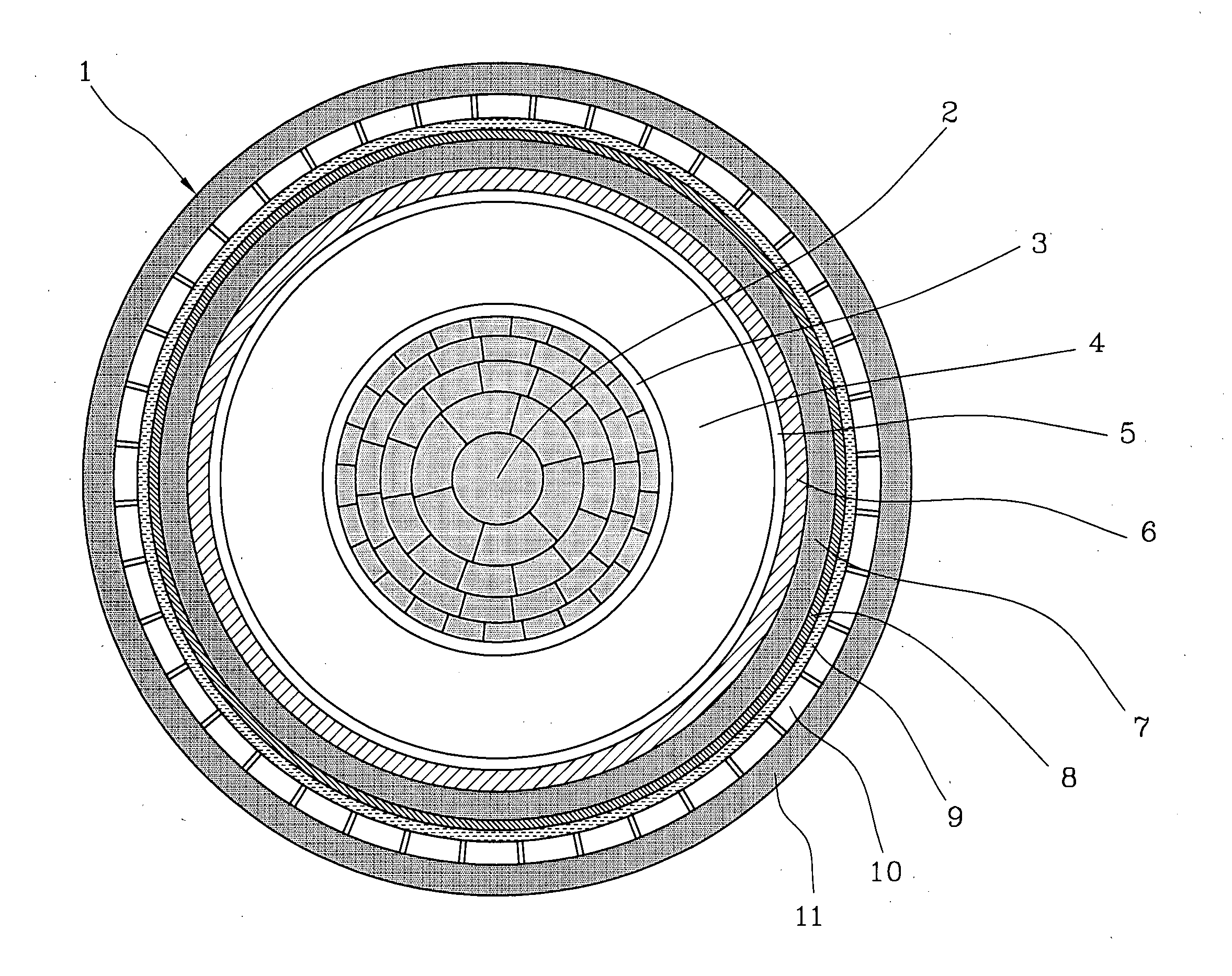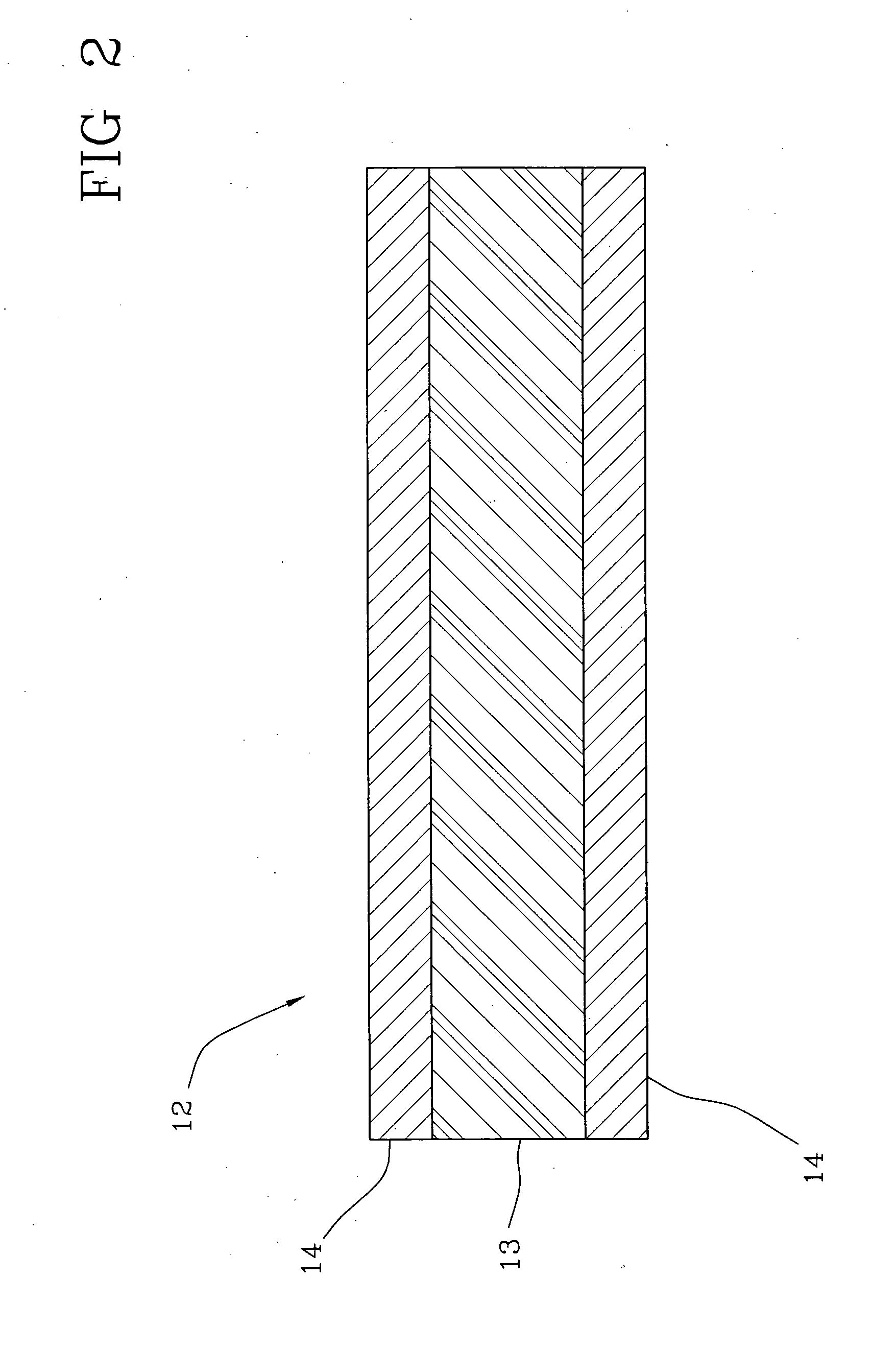High voltage direct current cable having an impregnated stratified insulation
- Summary
- Abstract
- Description
- Claims
- Application Information
AI Technical Summary
Benefits of technology
Problems solved by technology
Method used
Image
Examples
example 1
[0052]Two layers of kraft paper (pure conifer cellulose) having a thickness of 0.025 mm, a density of 0.93 g / ml and an air impermeability of 100,000 Gurley sec−1 were coupled with a layer of Pro-fax™ PF611 (Basell), a propylene homopolymer (PP) having a density of 0.902 g / ml (ASTM D 792) and a MFI @ 230° C. / 2.16 kg of 30.0 g / 10′ (ASTM D 1258). The resulting paper / PP / paper laminate had a thickness of 0.100 mm, a PP percentage content of 60% by weight and a weight of 100 g / m2. The peeling strength between PP and paper in the dry laminate was measured according to Standard ASTM D 1876-08 and resulted to be 13 g / 15 mm.
[0053]The so obtained laminate was dried in an oven under vacuum for 8 hours at 135° C. and then impregnated at 125° C. with an insulating fluid having a viscosity at 100° C. of 1200 cSt (commercial product T2015 by H&R ChemPharm (UK) Ltd.). During the impregnation process, the thickness variation (swelling) was measured at regular intervals: the results are reported in th...
example 2
[0055]Two layers of kraft paper (conifer pure cellulose) having a thickness of 0.025 mm, a density of 0.93 g / ml and an air impermeability of 100,000 Gurley sec−1 were coupled with a layer of HD601CF (Borealis), a propylene homopolymer (PP) having a density of 0.90 g / ml (ISO 1183) and a MFI @ 230° C. / 2.16 kg of 8 g / 10′ (ISO 1133). The resulting paper / PP / paper laminate had a thickness of 0.100 mm, a PP percentage content of 60% by weight and a weight of 100 g / m2. The peeling strength between PP and paper in the dry laminate was measured according to Standard ASTM D 1876-08 resulted to be 100 g / 15 mm.
[0056]The so obtained laminate was dried in an oven under vacuum for 8 hours at 135° C. and then impregnated at 125° C. with an insulating fluid having a viscosity at 100° C. of 1200 cSt (commercial product T2015 by H&R ChemPharm (UK) Ltd.).
[0057]During the impregnation process, the thickness variation (swelling) was measured at regular intervals: the results are reported in the diagram of...
example 3 (comparative)
[0058]Two layers of kraft paper (mixed conifer / broad leaved tree pure cellulose) having a thickness of 0.025 mm, a density of 1.01 g / ml and an air impermeability of 40,000 Gurley sec−1 were coupled with a layer of Pro-fax™ PF611 (Basell), a propylene homopolymer (PP) having a density of 0.902 g / ml (ASTM D 792) and a MFI @ 230° C. / 2.16 kg of 30.0 g / 10′ (ASTM D 1258). The resulting paper / PP / paper laminate had a thickness of 0.100 mm, a PP percentage content of 60% by weight and a weight of 100 g / m2. The peeling strength between PP and paper in the dry laminate was measured according to Standard ASTM D 1876-08 and resulted to be 50 g / 15 mm.
[0059]The so obtained laminate was dried in an oven under vacuum for 8 hours at 135° C. and then impregnated at 125° C. with an insulating fluid having a viscosity at 100° C. of 1200 cSt (commercial product T2015 by H&R ChemPharm (UK) Ltd.). During the impregnation process, the thickness variation (swelling) was measured at regular intervals: the res...
PUM
 Login to View More
Login to View More Abstract
Description
Claims
Application Information
 Login to View More
Login to View More - Generate Ideas
- Intellectual Property
- Life Sciences
- Materials
- Tech Scout
- Unparalleled Data Quality
- Higher Quality Content
- 60% Fewer Hallucinations
Browse by: Latest US Patents, China's latest patents, Technical Efficacy Thesaurus, Application Domain, Technology Topic, Popular Technical Reports.
© 2025 PatSnap. All rights reserved.Legal|Privacy policy|Modern Slavery Act Transparency Statement|Sitemap|About US| Contact US: help@patsnap.com



